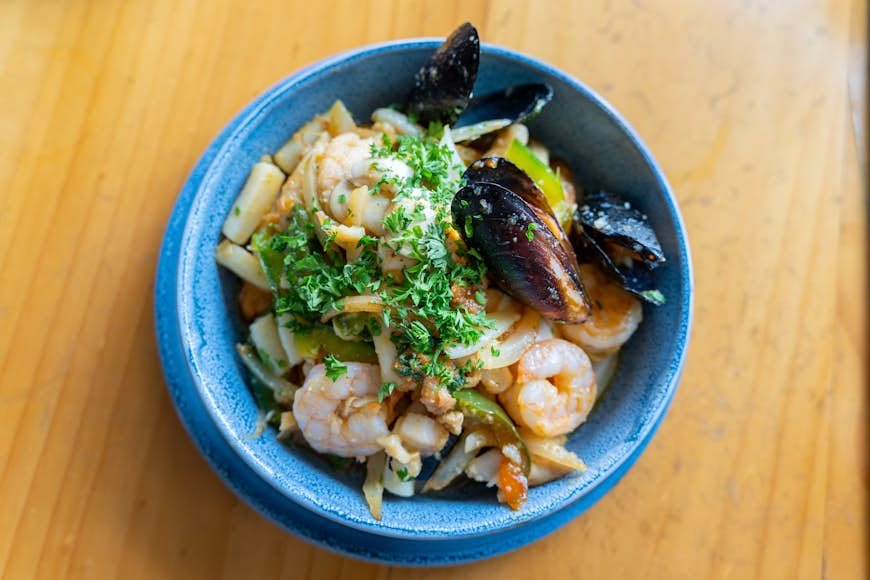
Traditional Costa Rican fare, for the most part, is comfort food, consisting largely of beans and rice, fried plantains and the occasional slab of chicken, fish or beef. Recently locals have started to experiment more with the country’s fresh and plentiful produce. The results have been inspiring and delicious.
Considering the extent of the coastline, it’s no surprise that seafood is plentiful here too, and fish dishes are usually fresh and delicious. Here’s what to eat and drink in Costa Rica, including the best traditional foods to try.
Get local insight on destinations all over the world with our weekly newsletter delivered to your inbox.
Guanabana
Also known as soursop, this sweet and sticky fruit should be purchased wherever you find it and eaten with your hands.
Where to try it: Tamarindo Farmer’s Market, near Playa Tamarindo on the Península de Nicoya.
Patí
A flaky, Caribbean-style turnover filled with meat, onions, garlic and spicy goodness. Great as a bus-ride snack and picnic treat.
Where to try it: Soda El Patty, a rustic nine-table Caribbean restaurant in Puerto Limón.
Street mango
Sold in plastic bags with salt, lime juice and sometimes chili powder, this is the ultimate refreshment.
Where to try it: The farmers market on Plaza Ferias in Alajuela.
Pipa fría
Find a vendor with a machete and an ice chest and they’ll hack off the top of a coconut, stick a straw in it, and you’re good to go, with a frosty, sweet treat.
Where to try it: Roadside vendors all across Costa Rica.
Pejivalle
The roasted peach-palm fruit is a roadside standard, delicious warm and salted, although Ticos like to add a dab of mayonnaise.
Where to try it: You can find freshly roasted pejivalle at many roadside stands across the country.
 Breakfast for Ticos is usually gallo pinto, a stir-fry of last night’s rice and beans © ©Esdelval/Getty Images
Breakfast for Ticos is usually gallo pinto, a stir-fry of last night’s rice and beans © ©Esdelval/Getty Images
Gallo pinto
Breakfast for Ticos is usually gallo pinto (literally “painted rooster”), a stir-fry of last night’s rice and beans. When combined, the rice gets colored by the beans, and the mix obtains a speckled appearance. Served with eggs, cheese or natilla (sour cream), gallo pinto is cheap, filling and sometimes downright tasty.
Where to try it: Sodas (cheap restaurants) across Costa Rica sell gallo pinto, but we love the beachside view that comes with the rice and beans at Sheriff Rustic on Playa Sámara. Plus it’s sold all day.
 While it’s not traditional Tico fare, ceviche is on most menut © Gianfranco Vivi / Getty Images
While it’s not traditional Tico fare, ceviche is on most menut © Gianfranco Vivi / Getty Images
Ceviche
While it’s not traditional Tico fare, ceviche is on most menus, usually made from pargo (red snapper), dorado (mahi-mahi), octopus or tilapia. The fish is marinated in lime juice with some combination of chili, onions, tomatoes and herbs. Served chilled, it is a delectable way to enjoy fresh seafood.
Where to try it: The fresh ceviche from the esteemed Café Liberia in Liberia is next level.
Chifrijo
Most bars offer the country’s most popular boca (snack), chifrijo, which derives its name from two main ingredients: chicharrón (fried pork) and frijoles (beans). Diced tomatoes, spices, rice, tortilla chips and avocado are also thrown in for good measure.
Where to try it: With knockout views of Laguna de Arenal and Arenal Volcano, La Ventanita in El Castillo sells the best chifrijo for miles.
Rondón
A spicy seafood gumbo, rondón‘s moniker comes from “rundown,” meaning whatever the chef can run down.
Where to try it: Maxi’s By Ricky does a great rondón soup in San José, while in the center of the capital, the wonderful Alma de Amón sells a rondón vegano with turmeric and coconut.
Vegetarians and vegans
Costa Rica is a relatively comfortable place for vegetarians to travel. Rice and beans, as well as fresh fruit, are ubiquitous, but there’s a lot more than that. Visit farmers markets to sample what’s in season: Costa Rica is a growers’ paradise.
Most restaurants will make veggie casados (set meals) on request, and many places are now including them on the menu. These set meals usually include rice and beans, cabbage salad and one or two selections of variously prepared vegetables or legumes.
With the high influx of tourism, there are many specialty vegetarian restaurants or restaurants with veggie menus in San José and in tourist towns, and even vegans will find some options in these places. Lodges in remote areas that offer all-inclusive meal plans can accommodate vegetarians with advance notice. The Happy Cow has a handy list of veggie restaurants nationwide.
Gluten-free, macrobiotic and raw-food-only travelers will have a tougher time, as there are fewer outlets accommodating those diets, although this is slowly changing. If you intend to keep to your diet, it’s best to choose lodgings where you can prepare food yourself. Many towns have macrobióticas (health-food stores), but the selection varies. Fresh vegetables can be hard to come by in isolated areas and are often quite expensive, but farmers markets are cropping up throughout the country.
Foods worth trying
Meal worms and crickets Bug museum Museo de Insectos has its own kitchen, where guests are served meal worms and crickets with lots of salt and oregano.
Mondongo Tripe intestines are a campesino (farmer) favorite in Costa Rica, and they are served surprisingly spicy.
Meat on a stick Is it pork? Chicken? Beef? Who cares. On roadsides and at local fiestas, this mysterious Tico delicacy is just as good as it smells, even after the vendor uses a paintbrush to apply spicy sauce.
A year in food
Food festivals are concentrated at the end of the rainy season, but the tropical Eden that is Costa Rica produces incredible fruits and vegetables and vends them in farmers markets year-round.
Rainy season (October and November)
Brave the rain for deliciously ripe mangoes and mamon chino (rambutan), plus agricultural celebrations such as the Fiesta del Maíz (Festival of Corn) and the Feria Nacional de Pejibaye (National Peach Palm Market).
Christmas (December)
Tamales, prepared with masa (corn meal soaked in lime), pork, potatoes and garlic and steamed in banana leaves, become a very big deal at this time of year.
Coffee harvest (September to January)
Many seasonal laborers from Nicaragua head down to pick grano de oro (the golden grain).



